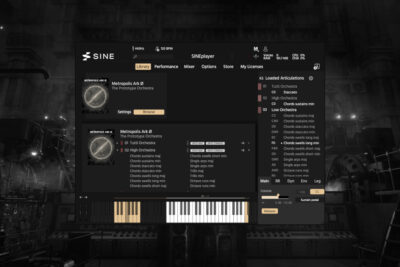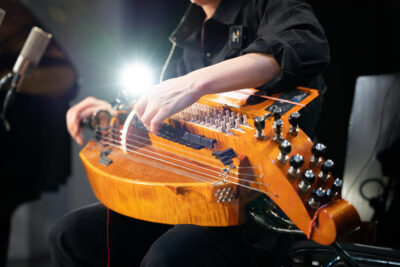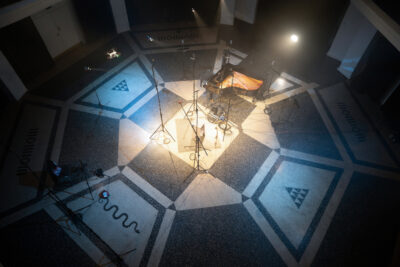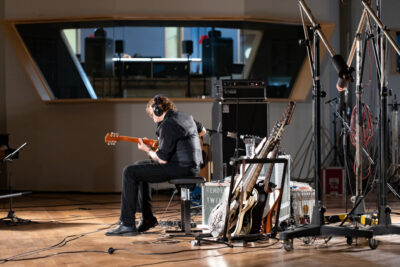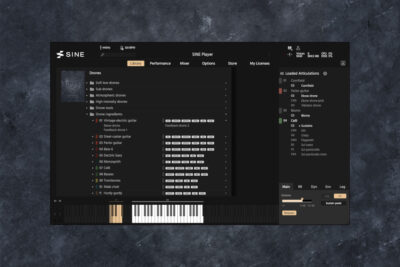Orchestral Tools Review: Expansive Options with Ark Ø and Drones
Two new sound collections provide composers and music producers with deep sonic possibilities, in this Orchestral Tools review.
Orchestral Tools have found a powerful way to add even more evocative elements to music and sound production with their recent collections, Metropolis Ark Ø and Drones.
Metropolis Ark Ø is the final chapter in their Metropolis Ark series, aptly named “Ark Ø” as it’s meant to be the precursor to all of the previous collections; and is a prototype orchestra with three main instruments within the collection, which functions as a large orchestra playing as a whole, with dark and aggressive characteristics.
Drones is an experimental take on Orchestral Tools’ collections, and was created with musician Alexander Hacke (Einstürzende Neubauten/hackedpicciotto) based on chromatic drones, utilizing instrumentation from around the world incorporating both old-world and new world approaches to creating long and contemplative drones. The drones were designed by Alexander Hacke with Sascha Knorr and Timo Loosli, creating sonic atmospheres that are perfect for film and/or game scoring. Some of the Drones samples are around a minute long, making them an endless base for creation. Both collections were recorded at the Teedex Scoring Stage and Silent Green, Berlin.
Exploring Ark Ø
Ark Ø is a tutti (meaning “all together”, as opposed to a soloist) orchestra recorded in multiple microphone positions. Included microphone positions to choose from are: Decca Tree, Tutti Orchestra, various spot mixes, Outrigger, AB, Surround, and more. I recommend watching the official walkthrough to really hear how one can balance and control these in Orchestral Tools SINEplayer, giving a lot of control over how and where the orchestra is heard from. This not only makes Ark Ø a well-recorded orchestra, but also one that is incredibly flexible to add into larger mixes and arrangements. Building on that, the entire Metropolis Ark series, as well as Orchestral Tools’ flagship Berlin series was recorded in the same studio with the exact same setup, to ensure seamless mixing and blending across collections.
The Ark0 collection is arranged into three main instruments; the Tutti Orchestra, High Orchestra, and Low Orchestra — within each of those the user will find various applications of the orchestra like long marcati, upbeats, chord swells, and trills. This is a very expressive orchestra and rather than thinking of triggering samples, one must really calibrate their playing to how an orchestra would express itself.
All of the orchestra is recorded in these thought-through, and perfectly applied microphone positions with orchestrated triads in all inversions. There is an expansive 31GB worth of material. The main instruments are dramatic and monumental in their expressive qualities, and were inspired by the early silent film era scores. The expressive quality of these recordings certainly lends itself to some evocative tonalities of the orchestra. The tutti orchestra was recorded playing in a more aggressive style, making it perfect for trailers, film scores, video game scores, and much more.
Into the Drones
Drones, curated and envisioned by Alexander Hacke, is a massive 362GB of material, which has a lot of playable intensity, including via the modwheel. (Users must have the very latest version of SINE, and the patches are 24bit/48KHz.) Some of the samples are about a minute long, and include instrumentation from the likes of bass, electric bass, steel caster, acoustic and electric guitars, celli, trombones, basso profoundo choir, hurdy gurdy, the Indian tanpura, didgeridoo, and Ebow piano.
The collection is arranged into instruments which can be purchased separately, if preferred. They are grouped together as: Soft Low Drones, Sub Drones, Atmospheric Drones, High Intensity Drones, Drone Tools, and Drone Ingredients. In true Orchestral Tools style all instruments are beautifully and methodically recorded in varying microphone positions, allowing absolute control for realistic microphone placement and balanced mixing.
In the Studio with Ark Ø and Drones
In use the Ark Ø instruments are very well recorded. The level of careful planning from the thought-out articulations, the dynamic usages, and the careful work that went into how the whole orchestra would communicate itself, in this aggressive state, works succinctly for a composer who desires the most control possible; it’s something quite special. For example, staccato expressions include increase in dynamic expression with harder playing via the MIDI controller, it would seem to be an intuitive no-brainer to do so, and a must, but this is a detail that not many libraries articulate or record as well. When not implemented at a high level it can make or break an orchestral collection of this kind.
To change mic position, navigate to the SINEplayer’s mix area and you can blend which microphone positions you would like to hear. As mentioned above everything from Decca Tree to spot mics and outriggers are included. There’s even options for surround mix (which I didn’t download.) You have the option to download microphone placements of your choosing, too! And this is true across all of the Orchestral Tools collections. Be sure to keep an eye on this if you don’t mean to download the surround positions, which will take up extra hard drive space and download time.
Additionally, in the same area that you navigate your mix of microphone positions, there is a tab for performance, which helps you see the key mapping for which expression you are using while you are playing or triggering the orchestra. There is more than one way to view the key mapping which is useful depending on how you like to visualize information, but also helpful in terms of screen real estate. Visually you can choose to have it front and center in focus on the SINEplayer, or you can keep it at the bottom visualized with the keyboard, while above it you might have the microphone placement mixer.
Some of this information is also echoed down the side panel of the SINEplayer, with a dot next to the orchestra expression you are currently working with. For example, the dot being next to “staccato” tells me that all samples are this expression for this instrument in the collection. Double click to choose it. If you are navigating from the bottom you’ll be working with a visualization that is based off of the piano keyboard, with an isolated and highlighted group of keys, allowing you to toggle between various expressions by clicking on those keys in that area.
In keeping with the high quality bespoke nature of Orchestral Tools’ collections, Drones radiates in a uniquely scintillating way. It blends timeless elements from Indian and medieval music (tanpura meets hurdy gurdy?!), with elements like didgeridoo and Ebow guitar/piano, to provide a carefully crafted and recorded bed of instrumentation that lends a very unique orchestral offering.
This is a substantial collection and quite expansive. The choir is a wonderful inclusion and any media composer would do well to have this in their arsenal. Orchestral Tools has done exceptionally well here in giving the composer the option to have some of these elements alone, still with the control of the microphone positions, and even further, with the use of the mod wheel, giving an additional range of very natural expression. To fully experience and appreciate what they have captured here, you need to spend some quality time just holding down a series of notes to really catch the drone ringing through to its fullest, while adjusting the mod wheel. Remember some of these samples are around a minute, so the sound does resonate and develop. It’s truly expansive, both in the volume and nuances of the sounds, but also in how it begins to paint a landscape for the listener.
To Be Critical
There are a few considerations to note. The SINEplayer isn’t as intuitive as I’d like for a first time user. (This was my first foray into the Orchestral Tools world.) I’d have liked the microphone position downloads to have been a bit more obvious, as I didn’t want the surround sound mic placements right now. I also found the keyboard mapping and layering a little less intuitive than I’d like. It all makes sense in the end, and isn’t overly complicated, which I appreciate — it’s a very clean interface.
The download defaults to all, so do watch out for that. The Drones collection will take at least half a day to download, and there’s nothing anyone could really do about that, it’s just a big library of long sounds carefully recorded. This is worth noting, however, because it’s not something you can undertake in a hurry — users should set aside time to get this one downloaded. On my high speed business grade connection it took about 8-14 hours to download both collections! I downloaded Ark Ø first, and then started on Drones, which on its own was at least 12 hours.
During my tests I did find a bug, and at first it had me scratching my head. Every software solution has them and even though it may not replicate on every system, because we are all using different setups, it is worth mentioning here. I was able to find and replicate it repeatedly, and to be fair has no bearing on the actual quality of the recordings, sampling, or the UI, but it did make me do a few double takes and question my caffeination levels. Basically, if you play any notes on your controller, while a patch is loading it will render your controller unresponsive once the patch is loaded. You can verify that the patch has loaded by using the mouse to trigger the loaded patch on the keyboard on the display in the SINEplayer, but you will not get a response from your controller. I then restarted my DAW and reinstantiated the SINEplayer to not only replicate but solve the issue. (I found this in Ark Ø and didn’t test to see if it would also be present in Drone, but my suspicion is that it’s native to SINE.) So in short, definitely don’t touchy the keys while you wait for the patches to load, which isn’t long to be fair! (I just happen to be very fidgety.)
Summing it Up
In closing, Orchestral Tools’ Ark Ø and Drones collections are recorded very thoughtfully, and with a lot of detail to the critical microphone placements, along with options to blend any of them together or keep them independent. Everything is meticulously organized into the SINEplayer, to facilitate making use of them as focused or as broad as you would like.
These characteristics make them great for creating a score for games, film, or for use in other innovative ways to make dramatic beds that would certainly add to any modern song. A good value for the money, Ark Ø and Drones are striking, quality orchestral tools-the sharpest in the box.
— Kallie Marie is a contributor to SonicScoop. She is the author of “Conversations with Women in Music Production“, available now from Backbeat Books.
Please note: When you buy products through links on this page, we may earn an affiliate commission.








